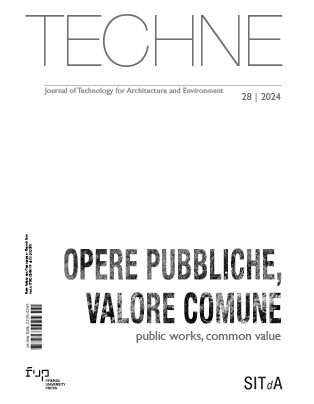Published 2024-10-29
Keywords
- Participated design,
- Multi actor design,
- User-driven design,
- Public works,
- Active citizenship
How to Cite
Copyright (c) 2024 Antonio Magarò, Massimo Mariani, Luca Trulli

This work is licensed under a Creative Commons Attribution 4.0 International License.
Abstract
The paper presents the results of a research carried out by the Department of Architecture of Roma Tre University about user-driven re-design of public spaces, with the aim of transforming them into accessible and inclusive public spaces. Activities are related to the case of Schuster Park in Rome, whose re-functionalisation in terms of accessibility and inclusiveness is currently being planned. With this target, the research team, during the support phase for a preliminary feasibility study, experimented with a recursive participatory model, which can also be applied to other contexts related to public spaces.
Downloads
References
- Baratta, A., Calcagnini, L., Finucci, F., Magarò, A., Molina, H. and Quintana Ramirez, H.S. (2017), “Strategy for better performance in spontaneous building”, TECHNE – Journal of Technology for Architecture and Environment, n. 14, pp. 158–167. Available at: https://doi.org/10.13128/Techne-20797.
- Baratta, A., Finucci, F. and Magarò, A. (2021), “Generative design process: multi-criteria evaluation and multidisciplinary approach”, TECHNE – Journal of Technology for Architecture and Environment, n. 21, pp. 304–314. Available at: https://doi.org/10.13128/techne-9822.
- Bobbio, L. (Ed.) (2004), A più voci. Amministrazioni pubbliche, imprese, associazioni e cittadini nei processi decisionali inclusivi, Edizioni Scientifiche Italiane, Roma.
- Calci, C. (2005), Roma archeologica, Adnkronos Libri, Roma.
- Commissione Europea (2022), European Awareness Scenario Workshop. Available at: https://cordis.europa.eu/article/id/8356-european-awareness-scenario-workshops/it (Accessed on 12/02/2024).
- Friedmann, J. (1993), “Toward a Non-Euclidian Mode of Planning”, Journal of the American Planning Association, n. 482, pp. 2-5. Available at: https://doi.org/10.1080/01944369308975902. DOI: https://doi.org/10.1080/01944369308975902
- Geddes, P. (1970), Città in evoluzione, Il Saggiatore, Milano.
- Lambertini, A. (2013), Urban Beauty. Luoghi prossimi e pratiche di resistenza estetica, Compositori, Bologna.
- Mussinelli, E. (2022), in Mariani, M. “La rigenerazione urbana: una bussola per la qualità della vita”, Costruire in Laterizio, n.188, p.42.
- Miccoli, S., Finucci, F. and Murro, R. (2015), “A direct deliberative evaluation method to choose a project for Via Giulia, Rome”, Pollack Periodica, Vol. 1, n. 10, pp. 143-153. Available at: https://doi.org/10.1556/pollack.2015.10.1.14. DOI: https://doi.org/10.1556/pollack.2015.10.1.14
- Migliorini, L. and Rania, N. (2001), “I focus group: uno strumento per la ricerca qualitativa”, Animazione sociale, Vol. 2, n. 150, pp. 82-88.
- Mumford, L. (2007), La cultura delle città, Einaudi, Torino.
- Owen, H. (2008), Open Space Technology, a user’s guide, 3rd ed., Berrett-Koeler Publishers, San Francisco.
- Savoldi, P. (2006), Giochi di partecipazione. Forme territoriali di azione collettiva, FrancoAngeli, Milano.
- Sienkiewics, M. W. (2022), “Problems and determinants of public participation in the creation of public space”, in Nines Silva, C. and Trono, A. (eds.) Local governance in the new urban agenda, Springer, Lisbona, PT, pp. 237-254. Available at: https://doi.org/10.1007/978-3-030-47135-4_12. DOI: https://doi.org/10.1007/978-3-030-47135-4_12
- Steizie, B. and Noenning, J. R. (2019), “A method for the assessment of public participation in urban development”, Urban Development Issues, n. 61, pp. 33-40. Available at: https://doi.org/10.2478/udi-2019-0005. DOI: https://doi.org/10.2478/udi-2019-0005
- Valente, A. (2009), Immagini di scienza e pratiche di partecipazione, Biblink, Roma.






